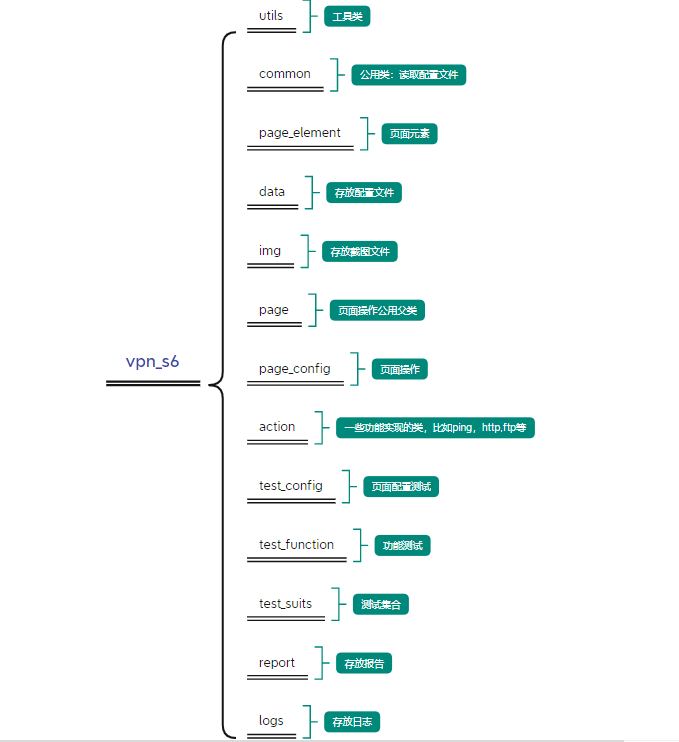简单搭建UI自动化框架
1、环境:
语言:python
IDE:pycharn
测试工具:selenium+unittest+beautifulreport
测试页面:某网络设备
2、框架目录:

3、下载chrome浏览器对应版本驱动:driver\chromedriver.exe
https://npm.taobao.org/mirrors/chromedriver
4、完成登录与注销的动作(话不多说、直接上代码)
浏览器驱动,放到common下:common\browser_engine.py
from selenium import webdriver
from common.conf_manage import config_manager
class BrowserEngine(object):
def __init__(self):
self.driver = webdriver.Chrome(executable_path=config_manager.CHROME_DRIVER)
# Chrome浏览器驱动
# self.driver = webdriver.Edge(executable_path=config_manager.EDGE_DRIVER)
# Edge浏览器驱动
browser_engine = BrowserEngine().driver数据文件:data\url.ini
[HOST]
host = http://1.1.1.1
[USERNAME]
username = admin
[PASSWORD]
password = admin配置文件管理:common\config_manage.py
import os
from utils.time import dt_strftime
class ConfigManager(object):
# 项目目录
BASE_DIR = os.path.dirname(os.path.dirname(os.path.abspath(__file__)))
# 页面元素目录
ELEMENT_PATH = os.path.join(BASE_DIR, 'page_element')
# 配置文件目录
CSV_PATH = os.path.join(BASE_DIR, 'data')
# driver文件
CHROME_DRIVER = os.path.join(BASE_DIR, 'driver\\chromedriver.exe')
EDGE_DRIVER = os.path.join(BASE_DIR, 'driver\\msedgedriver.exe')
# 报告文件
REPORT_FILE = os.path.join(BASE_DIR, 'report')
REPORT_NAME = '**测试报告'
# 截图
IMG_FILE = os.path.join(BASE_DIR, 'img')
@property
def log_file(self):
"""日志目录"""
log_dir = os.path.join(self.BASE_DIR, 'logs')
if not os.path.exists(log_dir):
os.makedirs(log_dir)
return os.path.join(log_dir, '{}.log'.format(dt_strftime()))
@property
def ini_file(self):
"""配置文件"""
ini_file = os.path.join(self.BASE_DIR, 'data', 'url.ini')
if not os.path.exists(ini_file):
raise FileNotFoundError("配置文件%s不存在!" % ini_file)
return ini_file
config_manager = ConfigManager()
if __name__ == '__main__':
print(config_manager.BASE_DIR)
print(config_manager.IMG_FILE)
读取ini文件:common\readini.py
import configparser
from common.conf_manage import config_manager
class ReadIni(object):
"""读取配置文件"""
def __init__(self):
self.config = configparser.RawConfigParser()
self.config.read(config_manager.ini_file, encoding='utf-8')
def get(self, section, option):
return self.config.get(section, option)
@property
def url(self):
return self.get('HOST', 'host')
@property
def username(self):
return self.get('USERNAME', 'username')
@property
def password(self):
return self.get('PASSWORD', 'password')
ini = ReadIni()
if __name__ == '__main__':
print(ini.url)浏览器操作基类:page\web_page.py
from selenium.common.exceptions import TimeoutException
from common.browser_engine import browser_engine
from utils.logger import log
class WebPage(object):
def __init__(self):
self.driver = browser_engine
# self.driver = driver
def get_url(self, url):
"""
打开网址
:param url: 网址
:return:
"""
self.driver.maximize_window()
self.driver.set_page_load_timeout(10)
try:
self.driver.get(url)
self.driver.implicitly_wait(10)
log.info("打开网页:%s" % url)
except TimeoutException:
raise TimeoutException("打开%s超时" % url)
def refresh(self):
"""
刷新页面
:return:
"""
log.info("刷新页面")
self.driver.refresh()
self.driver.implicitly_wait(10)
web_page = WebPage()
if __name__ == '__main__':
web_page.get_url("http://172.30.12.183")工具类:utils\logger.py
import logging
from common.conf_manage import config_manager
class Log:
def __init__(self):
self.logger = logging.getLogger()
if not self.logger.handlers:
self.logger.setLevel(logging.DEBUG)
# 写入文件
fh = logging.FileHandler(config_manager.log_file, encoding='utf-8')
fh.setLevel(logging.INFO)
# 输出到控制台
sh = logging.StreamHandler()
sh.setLevel(logging.INFO)
# 定义输出的格式
formatter = logging.Formatter(self.fmt)
fh.setFormatter(formatter)
sh.setFormatter(formatter)
# 添加到handler
self.logger.addHandler(fh)
self.logger.addHandler(sh)
@property
def fmt(self):
return '%(levelname)s\t%(asctime)s\t[%(filename)s:%(lineno)d]\t%(message)s'
log = Log().logger
if __name__ == '__main__':
log.info('hello world')工具类:utils\time.py
import datetime
def dt_strftime(fmt="%Y%m%d"):
"""
格式化时间
:param fmt "%Y%m%d %H%M%S
"""
return datetime.datetime.now().strftime(fmt)
if __name__ == '__main__':
print(dt_strftime("%Y%m%d%H%M%S"))元素定位:page_element\ele_login_logout.py
class ElementLoginLogout:
UserName = 'username'
Password = 'pass_word'
Login = 'loginIn'
Admin = 'user_td'
Logout = '//*[@id="user_popup"]/div[2]/div/span[3]/a'
element_login_logout = ElementLoginLogout()页面操作:action\login_logout.py
from selenium.webdriver.common.by import By
from page_element.ele_login_logout import element_login_logout
from page.web_page import WebPage
import time
class LoginLogout(WebPage):
def s6_login(self, username, password):
driver = self.driver
driver.find_element(By.ID, element_login_logout.UserName).send_keys(username)
driver.find_element(By.ID, element_login_logout.Password).send_keys(password)
time.sleep(2)
driver.find_element(By.ID, element_login_logout.Login).click()
def s6_logout(self):
driver = self.driver
driver.switch_to.default_content()
driver.find_element(By.ID, element_login_logout.Admin).click()
driver.find_element(By.XPATH, element_login_logout.Logout).click()
driver.switch_to.alert.accept()形成测试用例:test_function\test_login.py
import unittest
from action.login_logout import LoginLogout
from common.read_ini import ini
from utils.logger import log
class TestLoginLogout(unittest.TestCase):
def test_login(self):
login = LoginLogout()
login.get_url(ini.url)
login.s6_login(ini.username, ini.password)
log.info("登录")
def test_logout(self):
logout = LoginLogout()
logout.s6_logout()
log.info("退出")执行测试例:test_suites\test_suites_login_logout.py
import unittest
from common.conf_manage import config_manager
from test_function.test_login import TestLoginLogout
from BeautifulReport import BeautifulReport as bf
if __name__ == '__main__':
suite = unittest.TestSuite()
suite.addTest(TestLoginLogout('test_login'))
run = bf(suite)
run.report(filename=config_manager.REPORT_NAME, description='测试', report_dir=config_manager.REPORT_FILE)执行结果:

以上!



